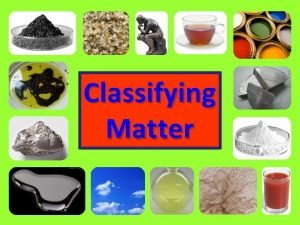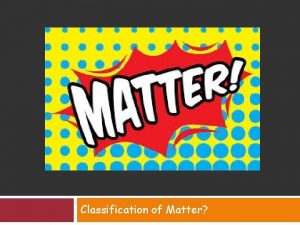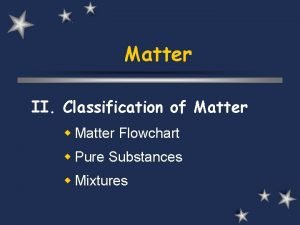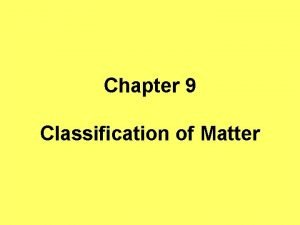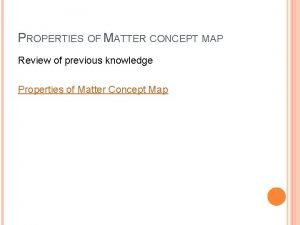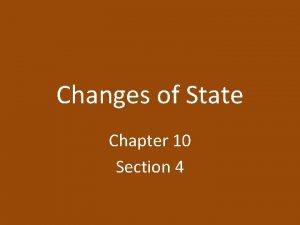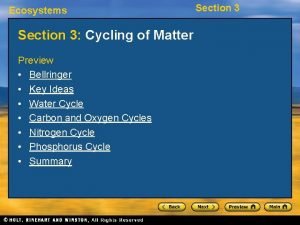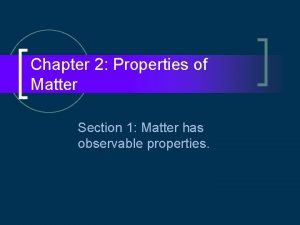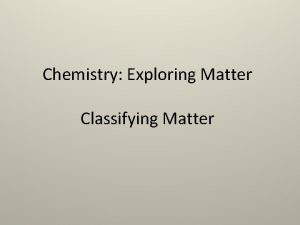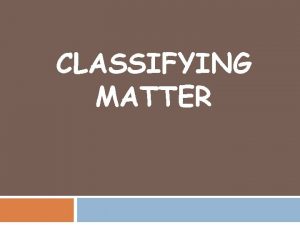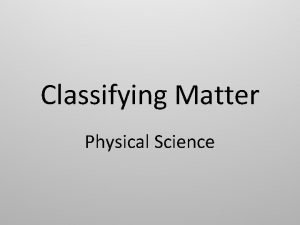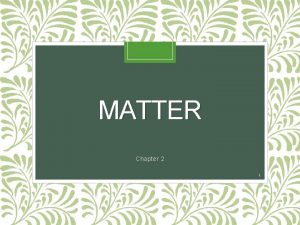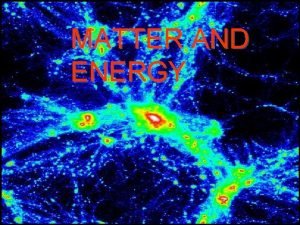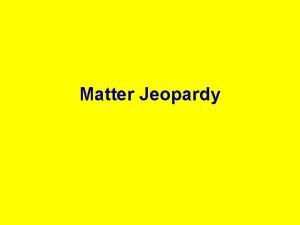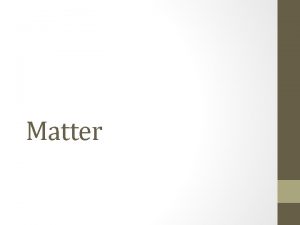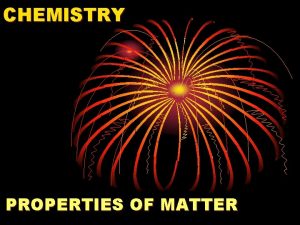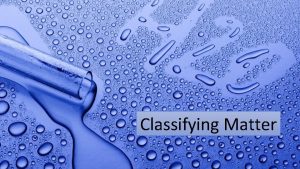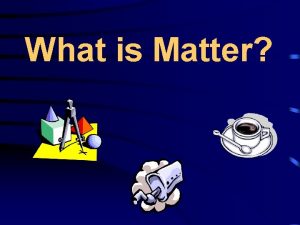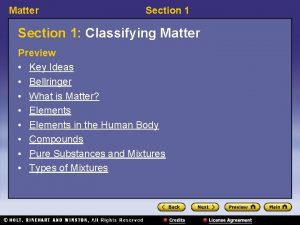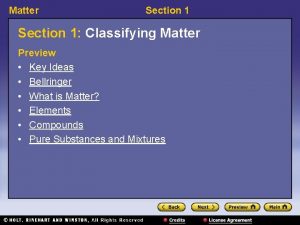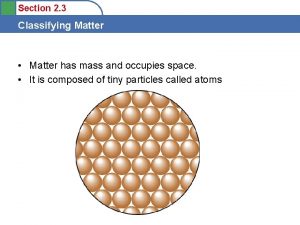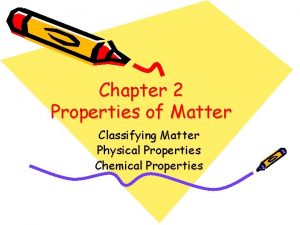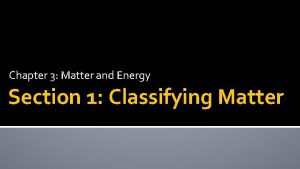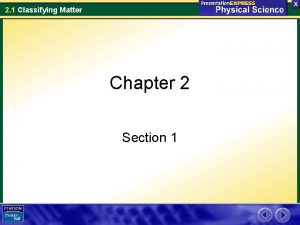Matter CHAPTER 2 1 Classifying Matter SECTION 1
























- Slides: 24

Matter CHAPTER 2 1

Classifying Matter SECTION 1 2

Matter §Matter: anything that has mass and takes up space (this includes air) §Chemistry: the study of matter §Can be classified as an element, compound or mixture 3

Elements §Elements: substances that cannot be broken down into simpler substances by chemical means §Made entirely of the same atom ◦ 112 known atoms ◦ 90 of those occur naturally ◦ less than 40 of those can be found naturally in elemental form ◦ Hydrogen, copper, gold, magnesium, lead, oxygen, nitrogen, helium, etc. §Elements cannot be separated into other things! 4

Elements §Elements are represented by a 1 -2 letter symbol §The first must always be a capital letter, and the second (if present, is lower case). ◦ C: Carbon ◦ He: Helium §Capitalization is VERY important when writing the symbol for an element CO = carbon monoxide Co = cobalt 5

Molecules §Molecule: two or more atoms bonded together §Smallest unit of a substance that will behave like the substance ◦ water, carbon dioxide, ammonia, glass, alcohol, and limestone 6

Compounds §Compound: substance made up of atoms of different elements (two or more elements chemically combined) §Compounds can be broken down into other things §This happens with a chemical change 7

Compounds §Compounds are represented by a chemical formula – symbols of the elements in them, and a subscript §A subscript shows how many there are of that atom in the compound §If there is no subscript number then 1 is implied, but you don’t write 1! 8

Pure Substances §Pure Substance: matter that has a fixed composition (make-up) and definite properties §Elements and compounds are pure substances, mixtures are not 9

Mixtures §Mixture: Compounds and/or elements mixed together but not bonded together. ◦ Substances that make up a mixture keep most of their own properties §Mixtures can be separated by simple physical means ◦ Iron and aluminum could be separated with a magnet, coffee grounds and water can be separated with a filter 10

Mixtures §Can be heterogeneous or homogeneous §Heterogeneous: different throughout or chunky, separation can be seen ◦ granite, orange juice with pulp, Italian dressing §Homogeneous: the same throughout, no separation can be seen ◦ metal alloys, air around you, milk and saltwater 11

Properties of Matter SECTION 2 12

Physical Properties §Any property that can be tested without changing the identity of the substance. ◦ For Example: mass, weight, density, volume, color, shape, texture, melting point, and boiling point. §Helps determine the use of the substance ◦ Aluminum is used in foil because it is lightweight, but durable and flexible 13

Density §Density: ratio of mass to volume of an object. D = m / v (density = mass / volume) §Density is a physical property §Measured in g/m. L (grams per milliliter), or g/cm 3 (grams per centimeters cubed) §Density of a pure compound or element is a constant (it never changes) ◦ Pure water is always 1. 0 g/m. L 14

Density §D = m / v §If an object has a mass of 24 g and a volume of 48 m. L, what is it’s density? D = 24 g / 48 m. L =. 5 g/m. L §If an object has a density of 1. 5 g/m. L, and it’s volume is 4 m. L. What is it’s mass? 1. 5 g = m / 4 m. L =6 g 15

Density §Less dense objects float in more dense objects. 16

Chemical Properties §Any property that can only be tested by changing the chemical make-up of the substance. ◦ Flammability, chemical reactivity, and ability to rust. 17

Changes of Matter SECTION 3 18

Physical Changes §Affects one or more physical properties of a substance without changing the identity of the substance ◦ Melting, cutting, crushing 19

Chemical Changes §Happens when one or more substances are changed into entirely new substances with different properties §Evidence of a chemical change ◦ bubbling, light, heat, color changes, an odor or a sound 20

Chemical Changes §You can tell a chemical reaction has occurred if the products are different from the reactants! §If there is no change it is NOT a reaction! ◦ e. g. ice melting is NOT a reaction, it is a physical change! 21

Physical or Chemical Change? §cutting a piece of ice in half § physical change §activating an instant ice pack (make it cold) § chemical change §melting ice § physical change §baking flour, sugar, egg and water together § chemical change 22

Separating Mixtures §Depending on the shape and size, you may can use physical properties to separate mixtures § use a filter, or a centrifuge §Solutions require distillation § boiling substances off one at a time) §Chemical properties could also be used to separate mixtures 23

Separating Compounds §Physical properties CANNOT be used to separate a compound §If it’s made of molecules, chemical properties CAN be used to separate it. ◦ Water can be separated into hydrogen and oxygen gas by electrolysis (a chemical change) 24
 Chapter 2 section 1 classifying matter answer key
Chapter 2 section 1 classifying matter answer key Section 1 composition of matter
Section 1 composition of matter Composition of matter section 1
Composition of matter section 1 Classification of matter section 1 composition of matter
Classification of matter section 1 composition of matter Classifying matter quiz
Classifying matter quiz States of matter flowchart
States of matter flowchart Classifying matter worksheet
Classifying matter worksheet What can matter be classified as
What can matter be classified as Copper wire classification of matter
Copper wire classification of matter Classification graphic organizer
Classification graphic organizer Classification of matter flow chart
Classification of matter flow chart Classification of matter quiz
Classification of matter quiz Concept map properties of matter
Concept map properties of matter Section 2 classifying chemical reactions
Section 2 classifying chemical reactions Chemical reactions section 2 classifying chemical reactions
Chemical reactions section 2 classifying chemical reactions Chapter 10 review states of matter section 4
Chapter 10 review states of matter section 4 Chapter 2 principles of ecology answer key
Chapter 2 principles of ecology answer key Concept mapping chapter 10 meiosis 1 and meiosis 2
Concept mapping chapter 10 meiosis 1 and meiosis 2 Grey vs white matter
Grey vs white matter Label the cranial dura septa and associated sinuses.
Label the cranial dura septa and associated sinuses. Gray matter and white matter
Gray matter and white matter Telecephalon
Telecephalon Ecological succession
Ecological succession Section 3 cycling of matter answer key
Section 3 cycling of matter answer key Chapter 2 properties of matter
Chapter 2 properties of matter







